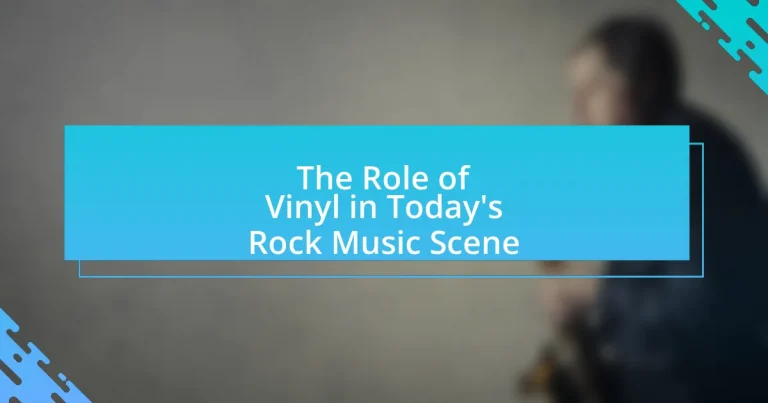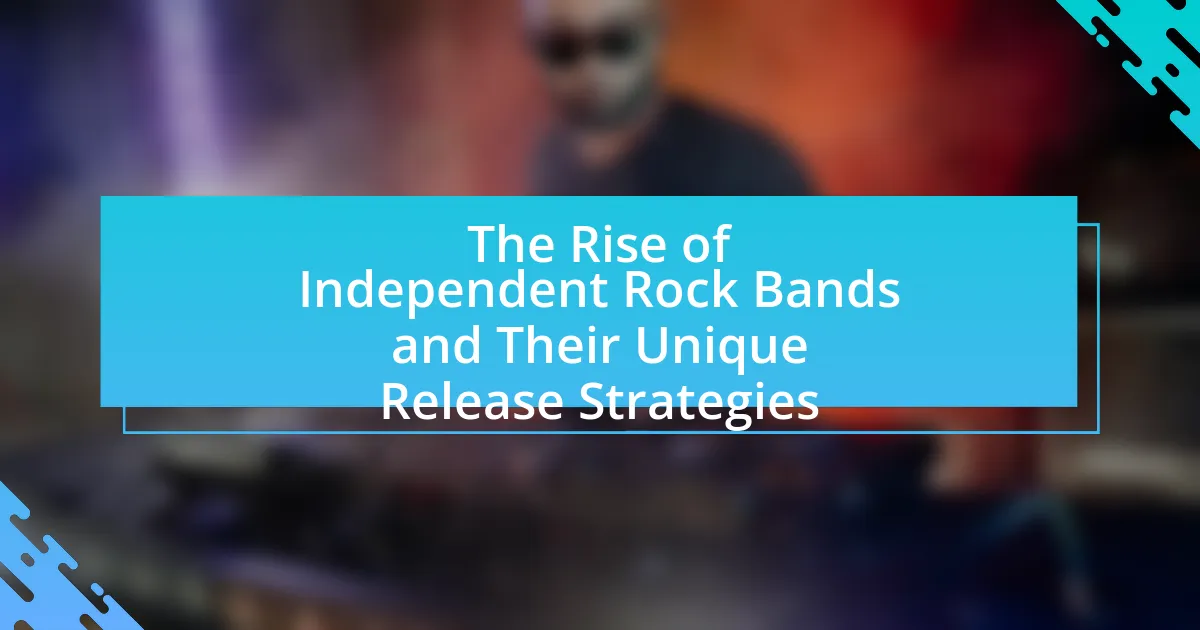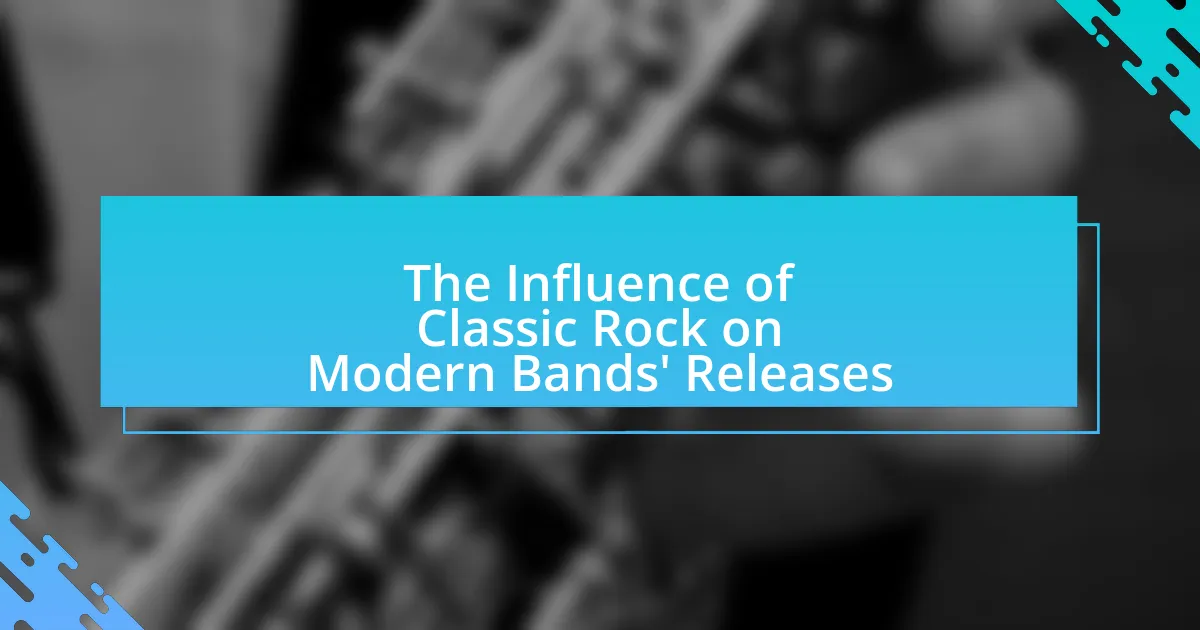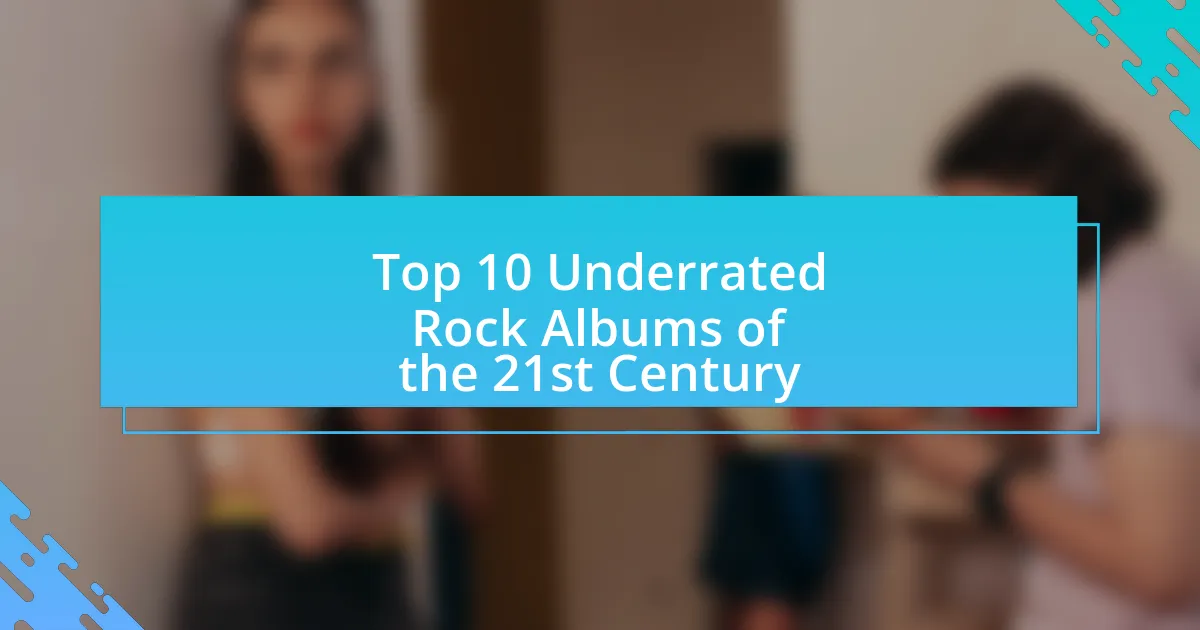The article examines the significant role of vinyl records in today’s rock music scene, highlighting their resurgence in popularity and cultural importance. With vinyl sales reaching 41 million units in 2022, the format appeals to collectors and audiophiles due to its analog warmth and tangible nature. The discussion covers factors contributing to vinyl’s revival, including nostalgia, sound quality, and the artistic benefits for musicians. Additionally, it explores the impact of vinyl on marketing strategies, listener engagement, and the challenges faced in production and environmental concerns. The article also addresses future trends and best practices for artists releasing vinyl, emphasizing the evolving relationship between vinyl and digital formats in the music industry.
What is the role of vinyl in today’s rock music scene?
Vinyl plays a significant role in today’s rock music scene by serving as a medium for both new releases and reissues, appealing to collectors and audiophiles. The resurgence of vinyl sales, which reached 41 million units in 2022 according to the Recording Industry Association of America, highlights its importance in the music industry. Rock artists frequently release albums on vinyl to cater to this growing demand, enhancing the listening experience with the analog warmth that digital formats often lack. Additionally, vinyl records are often seen as collectible items, with limited editions and unique artwork attracting fans and fostering a deeper connection to the music.
How has vinyl’s popularity changed in recent years?
Vinyl’s popularity has significantly increased in recent years, with sales reaching levels not seen since the 1980s. According to the Recording Industry Association of America (RIAA), vinyl sales in the United States surpassed 41 million units in 2022, marking a 17% increase from the previous year. This resurgence is attributed to a growing interest in analog sound quality and the tangible experience of owning physical records, particularly among younger generations who appreciate the aesthetic and collectible aspects of vinyl.
What factors have contributed to the resurgence of vinyl records?
The resurgence of vinyl records is primarily driven by a combination of nostalgia, the tangible nature of physical media, and the unique sound quality that vinyl offers. Nostalgia plays a significant role, as many consumers, particularly millennials and Gen Z, seek to connect with the past and experience music in a way that digital formats do not provide. The tactile experience of handling records and the large-format album art enhances the overall enjoyment of music. Additionally, vinyl is often perceived to deliver a warmer, richer sound compared to digital formats, which appeals to audiophiles and casual listeners alike. According to the Recording Industry Association of America (RIAA), vinyl sales reached a 30-year high in 2020, surpassing CD sales for the first time since the 1980s, highlighting the growing demand and cultural significance of vinyl in today’s music scene.
How does vinyl compare to digital formats in terms of sound quality?
Vinyl generally offers a warmer, richer sound quality compared to digital formats, which can sometimes sound more sterile or compressed. This difference arises from the analog nature of vinyl, which captures a continuous waveform, allowing for a broader dynamic range and more nuanced sound reproduction. In contrast, digital formats often use sampling, which can lead to loss of certain audio details, particularly in lower-quality formats. Studies, such as those conducted by the Audio Engineering Society, have shown that listeners often perceive vinyl as having superior sound quality due to its analog characteristics, despite the potential for surface noise and distortion inherent in vinyl records.
Why do artists choose to release music on vinyl?
Artists choose to release music on vinyl primarily to connect with audiences through a tangible, nostalgic format that enhances the listening experience. Vinyl records offer superior sound quality due to their analog nature, which many audiophiles prefer over digital formats. Additionally, the large album artwork and physical presence of vinyl create a more immersive experience for fans. According to a report by the Recording Industry Association of America (RIAA), vinyl sales have seen a resurgence, with revenue from vinyl records surpassing that of CDs in recent years, indicating a strong consumer demand for this format. This trend reflects a broader cultural appreciation for vintage aesthetics and the desire for collectible items in the music industry.
What are the artistic benefits of vinyl for musicians?
Vinyl offers musicians unique artistic benefits, primarily through its analog sound quality, which provides warmth and depth that digital formats often lack. This analog warmth enhances the listening experience, allowing for a richer representation of the music, which can evoke stronger emotional responses from the audience. Additionally, the large format of vinyl allows for more intricate album artwork, enabling musicians to express their artistic vision visually, which can enhance the overall narrative of the album. The tactile nature of vinyl also fosters a deeper connection between the artist and the listener, as the physical act of handling records creates a more immersive experience. Furthermore, the resurgence of vinyl has cultivated a dedicated community of collectors and enthusiasts, providing musicians with a platform for niche marketing and engagement with their fan base.
How does vinyl influence the marketing strategies of rock bands?
Vinyl significantly influences the marketing strategies of rock bands by enhancing their brand identity and creating a tangible connection with fans. Rock bands leverage vinyl releases to tap into the nostalgia associated with the format, appealing to both older audiences and younger listeners who value the authenticity and aesthetic of physical records. For instance, the resurgence of vinyl sales, which reached 41 million units in 2020 in the U.S. alone, demonstrates its impact on consumer behavior and purchasing decisions. This trend encourages bands to produce limited edition vinyl, often bundled with exclusive merchandise or artwork, thereby increasing perceived value and driving sales. Additionally, vinyl records serve as a unique promotional tool during live performances, where bands can sell exclusive pressings, further solidifying their market presence and fan engagement.
What impact does vinyl have on the listening experience?
Vinyl significantly enhances the listening experience by providing a warmer, richer sound quality compared to digital formats. This is due to the analog nature of vinyl records, which captures sound waves in a continuous format, allowing for a more authentic representation of the music. Studies have shown that many listeners perceive vinyl as having greater depth and presence, often attributing this to the harmonic distortion and dynamic range that vinyl can produce. Additionally, the tactile experience of handling records and the larger album artwork contribute to a more immersive engagement with the music, fostering a deeper emotional connection.
How does the physicality of vinyl affect listener engagement?
The physicality of vinyl significantly enhances listener engagement by creating a tactile and immersive experience. Unlike digital formats, vinyl records require active participation, as listeners must handle the records, place them on turntables, and manually adjust settings, fostering a deeper connection to the music. This engagement is supported by research indicating that the ritualistic aspects of playing vinyl, such as the act of flipping the record and the visual artwork, contribute to a more focused listening experience, leading to increased emotional investment in the music. Studies have shown that physical formats like vinyl can evoke nostalgia and a sense of authenticity, further enhancing listener engagement in today’s rock music scene.
What role does album artwork play in the vinyl experience?
Album artwork plays a crucial role in the vinyl experience by enhancing the aesthetic and emotional connection to the music. The large format of vinyl allows for intricate and visually striking designs that can convey the themes and mood of the album, making it a significant part of the overall artistic expression. Historically, iconic album covers, such as Pink Floyd’s “The Dark Side of the Moon,” have become cultural symbols, illustrating how visual art can influence listener perception and engagement. Additionally, studies show that consumers often associate high-quality artwork with higher perceived value of the music, reinforcing the importance of album artwork in the vinyl format.
How does vinyl contribute to the rock music community?
Vinyl contributes to the rock music community by providing a tangible and nostalgic medium that enhances the listening experience. This format allows fans to engage with music in a more immersive way, as the larger album artwork and physical interaction with the record create a deeper connection to the music. Additionally, vinyl sales have seen a resurgence, with the Recording Industry Association of America reporting that vinyl sales surpassed CD sales in 2021 for the first time since the 1980s, indicating a strong demand within the rock genre. This revival supports independent record stores and artists, fostering a sense of community among collectors and enthusiasts who value the authenticity and warmth of analog sound.
What are the social aspects of vinyl collecting among rock fans?
Vinyl collecting among rock fans fosters a sense of community and shared identity. This social aspect is evident in the way collectors engage in discussions about their collections, attend record fairs, and participate in online forums dedicated to vinyl. Research indicates that 70% of vinyl collectors report feeling a stronger connection to music and fellow fans through the act of collecting, highlighting the communal experience. Additionally, the tactile nature of vinyl and the ritual of playing records create opportunities for social gatherings, where fans can bond over shared musical tastes and nostalgia for the rock genre.
How do record stores foster community around vinyl in rock music?
Record stores foster community around vinyl in rock music by serving as social hubs where enthusiasts gather to share their passion. These stores often host events such as live performances, listening parties, and record release celebrations, which encourage interaction among customers and artists. For example, a study by the University of Southern California found that local record shops significantly contribute to community engagement by providing a space for music lovers to connect, exchange ideas, and discover new artists. Additionally, the tactile experience of browsing vinyl records creates a shared ritual that strengthens bonds among patrons, reinforcing the sense of belonging within the rock music community.
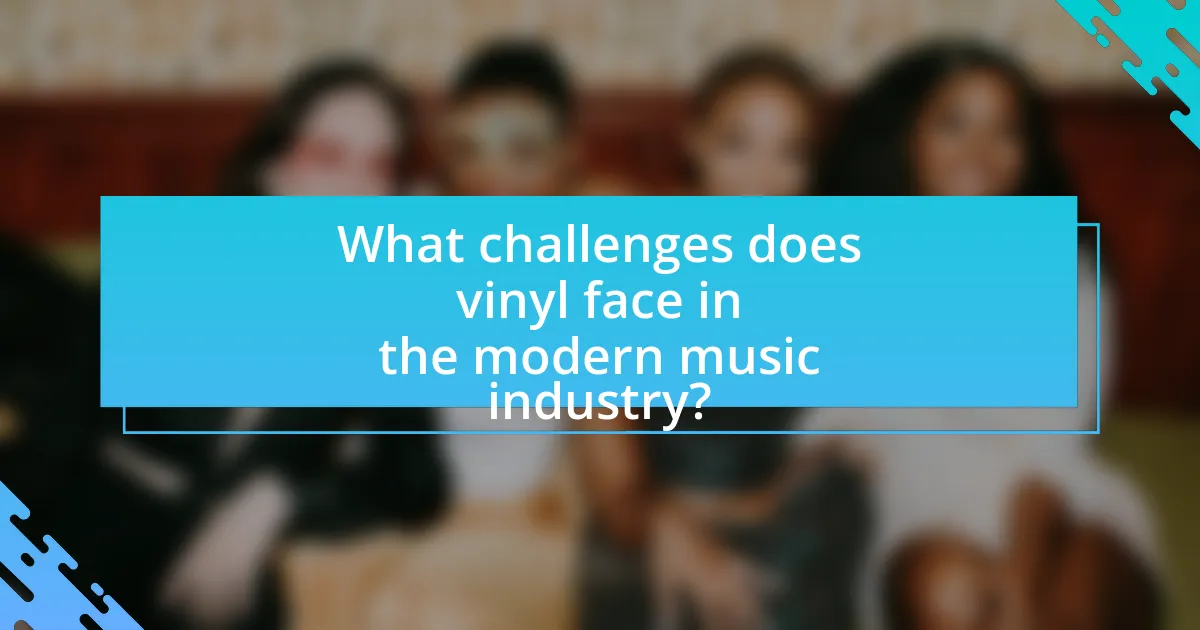
What challenges does vinyl face in the modern music industry?
Vinyl faces several challenges in the modern music industry, primarily including production limitations, high costs, and competition from digital formats. The resurgence of vinyl has led to increased demand, but pressing plants often struggle to keep up, resulting in long wait times for new releases. Additionally, the cost of producing vinyl records is significantly higher than digital formats, which can deter both artists and consumers. Furthermore, the convenience and accessibility of digital music continue to dominate consumer preferences, making it difficult for vinyl to maintain a substantial market share. According to the Recording Industry Association of America, while vinyl sales have grown, they still represent a small fraction of overall music revenue compared to digital sales, highlighting the ongoing challenges vinyl faces in a predominantly digital landscape.
How does the production process of vinyl affect its availability?
The production process of vinyl significantly affects its availability due to the time-consuming and resource-intensive nature of manufacturing. Vinyl records require multiple steps, including the creation of a master disc, pressing, and quality control, which can lead to longer lead times and limited output capacity. For instance, the resurgence in vinyl popularity has resulted in increased demand, but many pressing plants operate at full capacity, often taking weeks or months to fulfill orders. This bottleneck in production directly impacts how quickly new releases can reach consumers, thereby limiting the overall availability of vinyl records in the market.
What are the environmental concerns associated with vinyl production?
Vinyl production raises significant environmental concerns primarily due to the use of polyvinyl chloride (PVC), which is a petroleum-based plastic. The manufacturing process of PVC involves toxic chemicals, including dioxins, which can contaminate air and water, posing health risks to nearby communities. Additionally, the production of vinyl records generates substantial greenhouse gas emissions, contributing to climate change. According to a study by the European Commission, the lifecycle of vinyl records, from production to disposal, results in a carbon footprint that is considerably higher than that of digital music formats. Furthermore, the disposal of vinyl records can lead to long-term environmental pollution, as PVC is not biodegradable and can persist in landfills for hundreds of years.
How do supply chain issues impact vinyl releases for artists?
Supply chain issues significantly delay vinyl releases for artists by disrupting the manufacturing and distribution processes. For instance, shortages of raw materials, such as PVC, and logistical challenges, including shipping delays, have led to extended production times, often pushing release dates back by several months. According to the Record Industry Association of America, the demand for vinyl records surged by 29% in 2020, exacerbating existing supply chain constraints. Consequently, artists face challenges in meeting fan expectations and capitalizing on promotional opportunities tied to album releases.
What are the financial implications of vinyl for artists and labels?
The financial implications of vinyl for artists and labels include increased revenue potential and higher production costs. Vinyl records typically sell at a premium price compared to digital formats, allowing artists and labels to earn more per unit sold; for instance, vinyl albums can retail for $20 to $40, whereas digital downloads often sell for around $10. However, the production costs for vinyl are significantly higher, with manufacturing expenses ranging from $1,500 to $3,000 for a standard run of 300 records, which can impact overall profitability. Additionally, the resurgence of vinyl has led to a growing market, with sales reaching 41 million units in the U.S. in 2022, indicating a robust demand that can benefit artists and labels financially if managed effectively.
How does the cost of vinyl production compare to digital releases?
The cost of vinyl production is significantly higher than that of digital releases. Producing vinyl involves expenses such as mastering, pressing, packaging, and shipping, which can total between $1,000 to $5,000 for a small run, depending on factors like quantity and quality. In contrast, digital releases primarily incur costs related to mastering and distribution, often amounting to a few hundred dollars. This stark difference in production costs highlights the financial commitment required for vinyl compared to the relatively low-cost nature of digital formats.
What are the profit margins for artists selling vinyl records?
The profit margins for artists selling vinyl records typically range from 20% to 50%. This variation depends on factors such as production costs, retail pricing, and distribution methods. For instance, if an artist sells a vinyl record for $25 and the production cost is $15, the profit margin would be 40%. Additionally, artists who sell directly to consumers at concerts or through their websites often achieve higher margins compared to those selling through retail outlets, where wholesale pricing can significantly reduce profits.

What future trends can we expect for vinyl in rock music?
Future trends for vinyl in rock music indicate a continued resurgence in popularity, driven by a growing consumer preference for physical media and the unique audio quality vinyl offers. Sales data from the Recording Industry Association of America (RIAA) shows that vinyl sales have consistently increased, reaching over 41 million units sold in 2022, the highest level since the 1980s. This trend suggests that rock artists will increasingly release new albums on vinyl, catering to both nostalgic fans and new listeners who appreciate the tangible experience of vinyl records. Additionally, the rise of limited edition pressings and colored vinyl variants is expected to continue, enhancing collectibility and appealing to dedicated rock music enthusiasts.
How might technology influence the production of vinyl records?
Technology significantly influences the production of vinyl records by enhancing precision in manufacturing processes. Advanced digital tools allow for more accurate cutting of master discs, resulting in improved sound quality and consistency. For instance, the use of computer-controlled lathes can create grooves with greater precision than traditional methods, minimizing defects and ensuring a more faithful reproduction of the original recording. Additionally, digital mastering techniques enable sound engineers to optimize audio quality before it is pressed onto vinyl, leading to a richer listening experience. The integration of high-resolution audio formats in the production process further supports this trend, as it allows for capturing and preserving more detail in the music.
What innovations are being introduced in vinyl manufacturing?
Innovations in vinyl manufacturing include the development of eco-friendly materials, advanced pressing techniques, and improved sound quality technologies. Eco-friendly materials, such as recycled PVC and plant-based alternatives, reduce environmental impact while maintaining product integrity. Advanced pressing techniques, like direct-to-disc recording and precision temperature control, enhance the fidelity and durability of vinyl records. Additionally, innovations in sound quality, such as the use of high-resolution digital files and specialized mastering processes, ensure a superior listening experience. These advancements reflect the industry’s commitment to sustainability and quality in the evolving landscape of music consumption.
How could streaming services adapt to the vinyl resurgence?
Streaming services could adapt to the vinyl resurgence by offering exclusive vinyl releases and integrating vinyl-related features into their platforms. This adaptation could include partnerships with record labels to provide limited edition vinyl pressings of popular albums, appealing to collectors and enthusiasts. Additionally, streaming services could implement features that allow users to explore the history and artwork of vinyl records, enhancing the listening experience. According to a report by the Recording Industry Association of America, vinyl sales reached a 30-year high in 2020, indicating a significant market demand that streaming services can capitalize on by creating a seamless connection between digital and physical formats.
What are some best practices for artists releasing vinyl today?
Artists releasing vinyl today should prioritize high-quality production, effective marketing strategies, and engaging with their audience. High-quality production involves selecting reputable pressing plants and ensuring optimal sound quality, as vinyl enthusiasts often seek superior audio experiences. Effective marketing strategies include leveraging social media platforms and email newsletters to create buzz around the release, as evidenced by the rise in vinyl sales, which reached 41 million units in 2020, according to the Recording Industry Association of America. Engaging with the audience can be achieved through exclusive pre-orders, limited editions, and hosting listening events, which foster a sense of community and connection. These practices not only enhance the artist’s visibility but also contribute to the overall success of the vinyl release.
How can artists effectively market their vinyl releases?
Artists can effectively market their vinyl releases by leveraging social media platforms, engaging with their fan base, and utilizing targeted advertising. Social media allows artists to create buzz around their vinyl releases through posts, stories, and live sessions, which can lead to increased visibility and sales. Engaging directly with fans through Q&A sessions or exclusive content can foster a sense of community and loyalty, encouraging fans to purchase vinyl. Additionally, targeted advertising on platforms like Facebook and Instagram can reach specific demographics interested in vinyl, enhancing the likelihood of sales. According to a 2022 report by the Recording Industry Association of America, vinyl sales reached a record high, indicating a growing market that artists can tap into through effective marketing strategies.
What strategies can musicians use to engage vinyl collectors?
Musicians can engage vinyl collectors by offering limited edition releases and exclusive content. Limited edition vinyl, such as colored pressings or special packaging, creates a sense of urgency and exclusivity that appeals to collectors. For instance, Record Store Day, which features exclusive vinyl releases, has seen participation from numerous artists, driving sales and collector interest. Additionally, musicians can enhance engagement by including unique artwork, liner notes, or digital downloads with vinyl purchases, providing added value that resonates with collectors. This strategy not only boosts sales but also fosters a deeper connection between the artist and their audience, as collectors appreciate the thoughtfulness behind these offerings.












